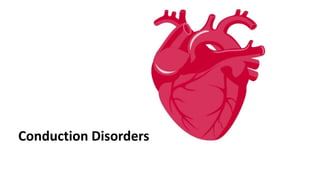
Conduction disorders.pptx
- 2. Heart functions Automatism - the ability of the cells to generate impulses without external stimulation. Conductivity - the ability of the heart to carry impulses from their place of origin to the contractile myocardium (atria and ventricles). Excitation - the ability of the cells of the conductive system of the heart and the contractile myocardium to respond to irritation by the generation of PD. Contractility - The ability of the heart to contract when excited.
- 3. Characteristics of the normal electrocardiogram The normal electrocardiogram is composed of а Р wave, а QRS complex, and а Т wave. The Р wave is caused by electrical potentials generated when the atria depolarize before atrial contraction begins. The QRS complex is caused by potentials generated when the ventricles depolarize before their contraction, that is, as the depolarization wave spreads through the ventricles. Therefore, both the Р wave and the components of the QRS complex are depolarization waves. The Т wave is caused by potentials generated when the ventricles recover from the state of depolarization. The Т wave is known as а repolarization wave.
- 4. Characteristics of normal sinus rhythm include: •P wave 0,06-0,10s •Interval P-Q 0,12-0,2s •QRS complex– 0,12s •Т wave – 0,16-0,24s
- 5. ECG evaluation 1. Determine the source of excitation. 2. Evaluation of the regularity of the heart rate. 3. Evaluation of heart rate If the rhythm is regular, HR=60/ R-R(s) 50 mm/s – 1mm=0,02s 25 mm/s – 1mm=0,04s
- 7. Etiology of heart rhythm disorder • 1) Functional violations and influences: violation of authonomous nerves system condition (sympathetic or parasympathetic link hyperactivity), physical work, body temperature changes; • 2) Organic injury of myocardium: inflammation of myocardium, necrosis of myocardium; • 3) Influences of toxic substances on the myocardium (alcohol, drugs, big dose adrenalin and noradrenalin, glucocorticoids, bacterial toxins); • 4) Hormone balance disorder (hyperthyroidism, hypothyroidism, hyperfunction of supranephral glands); • 5) Violation of intracellular or extracellular ions balance (changes of sodium, potassium, calcium, magnesium and chlorine concentration)
- 8. ARRHYTHMIAS CLASSIFICATION • Automatism violations • Excitability violations • Conduction violations • Combined violations (conduction and excitability)
- 9. Conduction violations - block Conduction violations are the results from abnormality impulse conduction. Conduction block can arise: - between SA node and atrium - inside atrium - In the AV nodal fibers, - in bungle of His,
- 10. 24hour ECG
- 11. Sinus atrial block Violation of impulses transmission from SA-node to atriums ECG : PQRST complex is absent compensatory pause is equal 2 (R-R)
- 13. Atrial block Violation of impulses transmission through the atrium conductive system ECG : Р duration >0,11 sec, Р - deformed (two waved)
- 14. АV-block Violation of impulses transmission through the AV node 1 degree 2 degree: Mobitz type I, Mobitz type II, type III (high degree AV block) 3 degree (complete AV block )
- 15. АV-block 1 degree • ECG : prolonged P-Q interval (>0,2 sec) in the result of retardation impulses conduction from atria to ventricles through AV node.
- 16. АV-block 2 degree • Mobitz type I (period of Venkebah) - Progressive increase of PQ duration (Venkebah’s pariods) until an impulse is blocked with after fall out QRST and then the cycle repeats again. R-R are different, rhythm is irregular and there are more P waves than QRS complexes. • АV-block 2 degree Mobitz type II - PQ are prolonged but their length is constant QRST fall out (periodicity is 3:1, some time 4:1) Symptoms: dizziness, unconsciousness
- 18. АV-block 3 degree (complete) • The conduction link between the atria and ventricles is lost. • Independent excitation and contraction of the atriums and ventricles • The atria continue to beat at a normal rate and the ventricles develop their own rate, which normally is slow (30-40/min, idioventricular rhythm) ECG : Р amount > QRS amount, P waves and QRS complexes appear independently. It causes periods of syncope, known as a Stokes-Adams attack (sings: asystole more than 10-20 sec, a decrease of cardiac output, insensibility, convulsions, possible death).
- 20. Treatment: 1. I or II degree AV block needn’t antibradycardia agent therapy 2. II degree II type and III degree AV block need antibradycardia agent therapy 3. Implant Pace Maker
- 22. Intraventricular Block • Etiology: Myocarditis, valve disease, cardiomyopathy, CAD, hypertension, pulmonary heart disease, drug toxicity, Lenegre disease, Lev’s disease et al. • Manifestation: Single fascicular or bifascicular block is asymptom; tri-fascicular block may have dizziness; palpitation, syncope and Adams-stokes syndrome
- 24. Intraventricular Block Therapy: 1. Treat underlying disease 2. If the patient is asymptom; no treat, 3. bifascicular block and incomplete trifascicular block may progress to complete block, may need implant pace maker if the patient with syncope